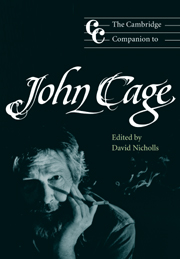8 - Music II: from the late 1960s
from Part II - Sounds, words, images
Published online by Cambridge University Press: 28 September 2011
Summary
Composition as process
John Cage is rightly celebrated for instructing us all in the pleasures of individuality, variety, and the unexpected. But it is also undeniable that certain consistencies underlie his work, from the earliest pieces to the last. Prime among these was his inclination to partition the act of composing into discrete processes or tasks, undertaken sometimes concurrently and sometimes in sequence. He sought above all to rationalize the creative impulse, to devise techniques and procedures which could be applied in an orderly fashion and which would allow the construction of engaging, useful works regardless of the composer's circumstances or state of mind. In this he differs importantly from other American experimentalists with whom his name is often linked: Cowell, whose theories were often applied intuitively and whose characteristic medium is the sketch; or Ives, a gifted improviser whose basic medium is collage.
Cage's best-known and most enduring systematization of the creative process was his reduction of composition to asking and answering questions: “as a comPoser / i shouLd / gIve up / makiNg / choicEs / Devote myself / to askIng / queStions / Chance / determIned / answers'll oPen / my mind to worLd around / at the same tIme / chaNging my music” (Cage 1988a, p. 15). But this position was preceded in the 1940s by a formalization of almost equal importance, which divided composition into four conceptual domains: materials, method, structure, and form.
- Type
- Chapter
- Information
- The Cambridge Companion to John Cage , pp. 128 - 148Publisher: Cambridge University PressPrint publication year: 2002
- 1
- Cited by



